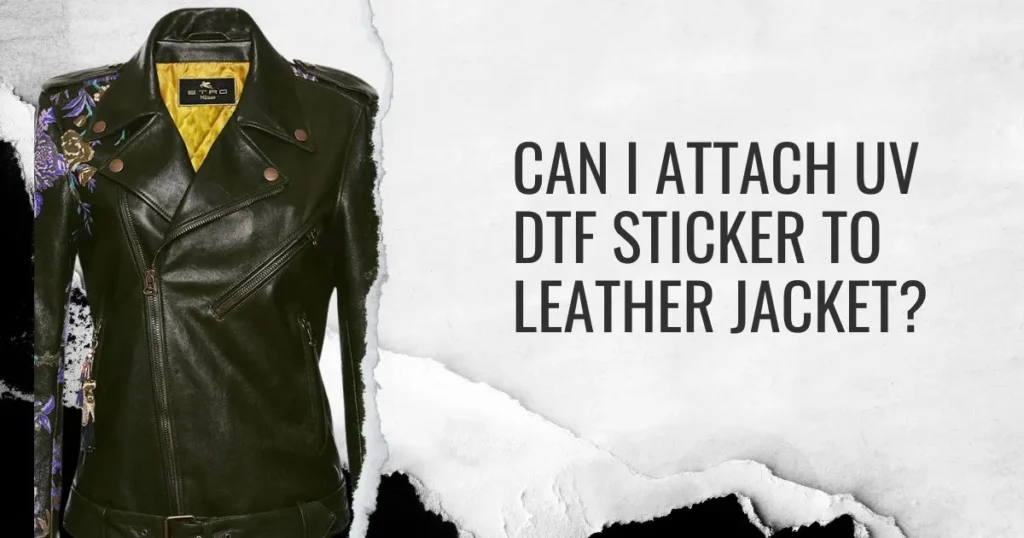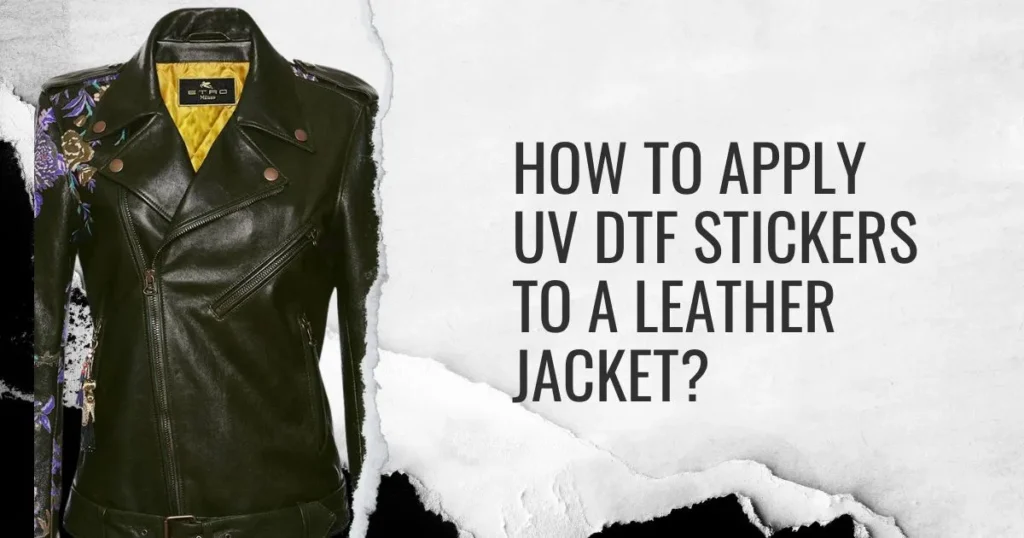Can i Attach UV DTF to Leather Jacket?

Can I attach uv dtf sticker to leather jacket? Short Answer: Yes. Attaching UV DTF sticker transfers to a leather jacket is entirely possible when you have the right materials and follow a few key steps. By properly preparing the leather, using the correct heat press settings, and ensuring quality transfers, you can transform an ordinary jacket into a personalized statement piece that reflects your unique style.
If you’ve ever owned a leather jacket—or even just admired one from afar—you already know its effortless cool factor can’t be denied. Leather is classic, versatile, and surprisingly customizable. As more and more people look to personalize their wardrobes, UV DTF on leather jackets has emerged as a top contender for creating designs that truly stand out. Whether you’re curious about how to apply UV DTF stickers to a leather jacket, worried about how durable UV DTF is on leather, or just eager to try something new, you’re in the right place.
In this guide, I’m going to walk you through the ins and outs of using UV DTF (Direct to Film) on leather jackets. We’ll talk about the different leather types, the best methods for preparing your jacket, and how you can avoid common pitfalls—like peeling stickers or damaged surfaces. And if you’re more of a “let’s do this ourselves” kind of person, don’t worry—I’ve got plenty of DIY tips, too. Let’s jump in!
Why Leather Jackets Are Perfect for UV DTF Customization
Let’s face it: leather jackets have always been a symbol of rebellion and self-expression. From Hollywood icons to everyday style enthusiasts, folks everywhere seem to gravitate toward this timeless piece. But what if you want to push the envelope and make your jacket look truly one-of-a-kind?
Longevity: Real leather isn’t just about looking great—it’s also about durability. A well-made leather jacket can last for years if you take care of it. By customizing it using UV DTF, you won’t just be adding a design; you’ll be making a long-lasting statement.
Smooth Surface: Genuine leather, especially when it’s not overly textured or treated, offers a relatively smooth canvas for printing. This smoothness helps the UV DTF transfers attach cleanly, giving you crisp, vibrant designs.
Style Flexibility: Leather jackets come in countless styles—biker, bomber, racing, and more. Whether you’re adding a subtle logo on the chest or going big on the back panel, UV DTF makes it possible to tailor your jacket to your personal aesthetic.
A Quick Intro to UV DTF Printing Technology
Before you start picturing your dream design on your jacket, it helps to know what UV DTF actually is. DTF stands for “Direct to Film,” but the “UV” part is what makes it special. UV DTF uses ultraviolet light to cure the ink, leading to vibrant, long-lasting designs. Here’s why that matters:
1. Fast Curing: Because it’s ultraviolet-cured, the ink sets quickly. This reduces the risk of smudging, blotching, or uneven color.
2. Versatile Application: UV DTF can be used on a variety of surfaces—fabric, metal, glass, and of course, leather. That versatility opens up countless creative possibilities.
3. High Detail: Looking to print tiny text or complex art? UV DTF can handle sharp edges and fine lines pretty well, giving your design a polished, professional look.
4. Strong Adhesion: When done right, these transfers bond securely with the leather surface, improving durability so your design doesn’t peel easily.
It’s almost like you’re getting professional, screen-print level results—only with more flexibility and fewer limitations. Of course, that’s only if you prep your jacket properly and use the right printing process.
Types of Leather and Their Compatibility with UV DTF
Not all leather is created equal. If you’re eyeing this method for an old thrifted jacket or a pricey new purchase, you need to know what you’re working with first. Let’s break it down:
Genuine Leather
Real leather (taken from animal hides) is typically your best bet. Since genuine leather can handle higher temperatures and has those natural fibers that help the ink bond better, it’s ideal for UV DTF. You do, however, need to watch out for any coatings or finishes that might interfere with adhesion.
Faux Leather
Also referred to as PU leather or PVC leather, faux leather is a synthetic alternative. If you’re wondering, “Can I use UV DTF on genuine leather jackets? or “UV DTF for faux leather jackets?”—it can work on both. Faux leather might be trickier depending on how plastic-like the surface is. Some have extra glossy coatings that require adjustments in heat press settings or special primers.
Bonded Leather
Bonded leather is made from leftover scraps pressed together with adhesives. Generally, it’s less durable and might not handle heat as well as real leather. If you absolutely must try UV DTF on bonded leather, do a small test first to see if your design will stick.
Heavily Textured Leather
Embossed or extremely grainy leathers can cause issues because the ink or adhesive might not fill in all the tiny grooves. If your jacket has a light texture, it might still work, but heavier grains or embossed patterns can lead to patchy prints and a less consistent final look.
Key Takeaway: Genuine leather without heavy treatments or embossing is the sweet spot. If you’re unsure about your jacket’s material, try a small test patch to see how the leather reacts to heat, pressure, and adhesives.
Prepping Your Leather Jacket for UV DTF
Preparation can make or break your project. The last thing you want is a peeling print or scorched leather. So, how do you get your jacket ready?
Clean the Surface
Start by gently wiping the jacket with a damp cloth to remove dust or grime. If it’s an older jacket, consider a specialized leather cleaner. Make sure to let the leather dry thoroughly. Any moisture can interfere with how the UV DTF adheres.
Condition or De-Gloss
Conditioning can help if your leather is extremely stiff or old. This step hydrates the leather so it won’t crack under heat press pressure. On the flip side, if your leather is too glossy or slippery, a mild de-glosser (commonly used for leather painting) can help the ink grip better.
Choose the Right Adhesive Method
Some folks like to use a light adhesive spray on the platen or on the back of the film to keep things in place. Others prefer a tacky printer platen that holds the jacket flat without shifting. Either way, you want to ensure your jacket stays perfectly still during the transfer.
Test Run
Seriously—always do a test run on a hidden part of the jacket. Maybe inside a pocket flap or a small patch near the lining. This quick test helps you confirm that your temperature settings, pressure, and design will work as intended.
Step-by-Step: How to Apply UV DTF Stickers to a Leather Jacket

Now for the fun part—the actual application! Whether you’re a total newbie to heat pressing or a seasoned DIYer, here’s a straightforward guide.
Heat Press Setup
Preheat your press to the recommended temperature, which often hovers around 280–320°F for leather (but always check the instructions for your specific UV DTF product).
Position the Design
Lay your jacket on the platen, smoothing out any wrinkles or folds. Then carefully place the UV DTF transfer where you want it. Double-check alignment—especially for larger designs—by measuring from seams or using a ruler to keep it centered.
Apply Pressure and Heat
Close the heat press, applying firm but not excessive pressure. Depending on the film, you might only need 10–15 seconds, or it could be up to 30 seconds. Refer to the product guidelines for optimal timing.
Peel Carefully
Once the timer is up, open the press and let the jacket cool slightly—some UV DTF products require a “hot peel,” others need a “cold peel.” Always follow the instructions.
Final Inspection
Look for any areas that might have lifted. If you see a small corner coming loose, sometimes you can fix it by re-pressing that area under a Teflon sheet for a few extra seconds.
And that’s it! You’ve just applied UV DTF to a leather jacket. Give yourself a pat on the back, but also remember not to stress the new design immediately by folding or wearing it right away. Let it settle and cure fully.
Common Troubleshooting Tips
Even if you follow every step perfectly, mishaps can happen. Here are a few common issues and how to fix them:
Peeling Edges: This often means either the temperature wasn’t high enough, the pressure was too low, or the peel timing was off. Try increasing the press time or temperature slightly, and be sure to peel correctly (hot or cold) depending on the film’s instructions.
Cracks in the Design: This can occur if the leather is too stiff or if the print was stretched right after application. Using a leather conditioner before you press might help. Also, allow the transfer to cool and set before wearing.
Inconsistent Colors: Sometimes the ink might appear blotchy if your surface wasn’t fully cleaned. That’s why prep is so crucial. A thorough cleaning and ensuring the jacket is free from oils can help produce even coloration.
Damage to the Leather: If you’re seeing shiny spots or dark marks, your temperature might be too high, or you left the press on for too long. Leather is a bit more sensitive than standard cotton, so err on the side of caution and do test prints.
UV DTF vs. Traditional Stickers for Leather Jackets
You might be wondering, “Is UV DTF really better than just slapping on a regular vinyl sticker?” Here’s the breakdown:
Longevity: Traditional stickers often peel and fade over time, especially on flexible surfaces like leather. UV DTF forms a stronger bond and tends to last longer.
Aesthetics: UV-cured transfers allow for more detail, brighter colors, and a smoother finish. Regular stickers can look dull or can appear “raised” off the leather.
Customization: While vinyl stickers can be custom-made, they generally have design and color limitations. UV DTF can handle high-resolution imagery, gradients, and even photorealistic graphics.
Feel: Stickers sometimes feel plasticky or rough to the touch. A well-applied UV DTF design often feels like it’s part of the jacket, not just on top of it.
If you’re serious about a professional look and long-lasting wear, UV DTF definitely takes the gold. On the other hand, if you just want a quick, temporary option, a standard vinyl sticker might be enough. It all depends on your goals and how permanent you want your design to be.
Creative Design Ideas for Your Leather Jacket
Let’s talk fun stuff—design ideas. Once you’ve got the technique down, the sky’s the limit. Here are some ways you can harness UV DTF to make your jacket pop:
1. Bold Back Panel: Go big on the back with a large illustration or quote. This is perfect for band logos, art pieces, or any statement you want to make loud and clear.
2. Subtle Front Detail: If you prefer low-key customization, place a small symbol or design on the chest pocket or collar. It’s more discreet but still adds that personal flair.
3. Sleeve Accents: Don’t forget you can apply UV DTF on leather jacket sleeves, too. Flames, tribal patterns, or repeated text running down the sleeve can create a striking look.
4. Color Block Sections: Feeling really creative? Use UV DTF to color-block sections of your jacket. You can incorporate shapes or patterns that break up the monotony of plain leather.
5. Combine with Embellishments: Just because you have a UV DTF transfer doesn’t mean you can’t add more detail. Try mixing in metal studs, patches, or embroidered elements for a layered, mixed-media vibe.
If you’re customizing jackets commercially, these ideas can help you stand out. Searching for resources like “Where to buy UV DTF transfers for leather jackets” or “Top-rated UV DTF sticker suppliers for leather jackets” can connect you with high-quality products for your enterprise.
Caring for Your Newly Customized Leather Jacket
Once you’ve gone through the trouble of creating a masterpiece, the last thing you want is to ruin it. Proper care isn’t complicated, but it’s worth keeping a few pointers in mind:
Avoid Excessive Moisture: Even though UV DTF prints are quite robust, soaking your jacket in water or getting caught in the pouring rain can still degrade the leather over time. If it does get wet, gently pat it dry with a clean cloth.
Store It Properly: Hang your jacket on a sturdy hanger to maintain its shape, and keep it in a cool, dry place. Avoid throwing it on a chair where it can wrinkle the design.
Clean Gently: If you need to clean your jacket, stick to mild leather cleaners and a soft cloth. Avoid scrubbing directly over the design with harsh chemicals.
Condition Periodically: Real leather benefits from occasional conditioning to keep it supple. This also helps preserve the UV DTF design by preventing cracks in the leather itself.
Spot Check the Print: Over time, check the edges of your design. If you notice any lifting or peeling, a quick re-press (with a protective sheet) might fix small issues.
Following these steps goes a long way in keeping both your jacket and design looking sharp. If you’ve wondered, “How do you clean a leather jacket with UV DTF prints?”, the short answer is just be gentle and mindful, focusing on overall leather care.
Final Thoughts
Customizing leather jackets with UV DTF is a fantastic way to express yourself, stand out in a crowd, or even bring a fresh edge to a vintage piece. The key is all in the preparation: knowing your leather type, cleaning it properly, using the right heat press settings, and following the peel instructions carefully. Once you’ve nailed down the process, the possibilities are endless—bold back pieces, subtle accents, sleeve details, and more.
Remember, the steps and guidelines provided here aim to keep your jacket looking amazing, but every leather is a bit different. Don’t be afraid to experiment. Just make sure to test your method before committing to a big design. After all, the best fashion statements often come from daring to do something a little different.
Whether you’re a DIY enthusiast looking to jazz up your own closet, or a business seeking professional UV DTF solutions for fashion brands, this approach offers the perfect marriage of style, durability, and creativity. So go ahead—let your imagination run wild, and wear your art proudly on your sleeve (literally)!
FAQs
Can I attach UV DTF stickers to a leather jacket?
Absolutely Yes! Just make sure you’re working with suitable leather (preferably genuine and not heavily textured). Clean the surface thoroughly, use the right adhesive or heat press method, and follow the curing instructions.
Will UV DTF damage my leather jacket?
Not if you do it right. Using proper heat settings and a quality transfer product ensures the jacket stays in great shape. Always do a test run to avoid unexpected discoloration or damage.
How durable is UV DTF on leather?
It’s known for being quite durable—much more so than many traditional stickers. If your jacket is prepped well and you follow the recommended application steps, the design should hold up for a long time.
How do I prepare a leather jacket for UV DTF application?
Clean the surface, condition if necessary, and remove excess gloss if the leather is too shiny. Ensuring the jacket lies flat on the platen during pressing helps keep the design from shifting.
Is a heat press needed for UV DTF on leather jackets?
Most of the time, yes. A heat press provides consistent temperature and pressure, which are critical for proper adhesion. Some small designs might be applied with a specialized handheld tool, but for the best results, go with a heat press.
How can I prevent peeling of UV DTF on leather jackets?
Peeling usually happens when there’s not enough heat, pressure, or time under the press—or if you peel too early. Make sure you follow the product’s guidelines and let the design cool if it’s a cold-peel transfer.
Where can I buy UV DTF transfers for leather jackets
Many online retailers specialize in high-quality UV DTF sheets for leather customization. Check commercial printing suppliers or websites dedicated to custom apparel printing. Look for phrases like “Best DTF printer for small business” or “UV DTF printing services for leather jackets” if you need more professional guidance.
What type of leather is best for UV DTF applications (genuine, faux, bonded)?
Genuine leather is generally the best choice because it handles heat well and offers a smoother surface. Faux leather can also work, but test it first since some synthetic materials might warp or melt.
How do I clean a leather jacket with UV DTF prints?
Gently wipe it with a soft cloth and a mild leather cleaner. Don’t scrub directly on the design. After cleaning, pat it dry and let it air out naturally.
What are the advantages of UV DTF over other methods for leather customization?
UV DTF provides highly detailed, vibrant designs and strong adhesion. Unlike regular vinyl stickers, UV-curable inks bond better with the leather surface, leading to a longer-lasting print that resists peeling and fading.
Last Updated on February 6, 2025 by Muhammad Haseeb

